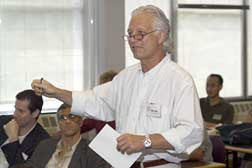Cornell engineers and Weill Cornell neurosurgeons gather to forge partnership for medical advancement
By Lauren Gold

Every neurosurgeon who uses a common gadget called a bipolar cauterizing instrument during a procedure faces a small but vexing technical problem.
The material of the instrument sticks to brain tissue. So when it is pulled away at the end of a surgery, it often causes a small tear.
Surgeons learn techniques to avoid damage. But the dilemma is just one example of ways in which crucial biomedical technology in neurosurgery could be improved.
This Thursday and Friday, July 20 and 21, 10 of the 13 faculty members in the Department of Neurosurgery at Weill Cornell Medical College are visiting Ithaca to forge a new collaboration with Cornell's Department of Biomedical Engineering. The goal of the meeting, said Philip Stieg, chair of the department of neurosurgery, is to mingle with biomedical engineering faculty, learn about research on the two campuses, and begin collaborations that could lead to better treatments and procedures for diseases from epilepsy to brain aneurisms to Parkinson's Disease -- and beyond.
It's a well-timed collaboration, said Michael Shuler, S.B. Eckert Professor of chemical and biomolecular engineering and chair of the biomedical engineering department. "Biomedical engineering is in a period of rapid growth," he said. "For us to be as competitive and successful as we can be, the interaction with the medical school has to be good."
In the past, Stieg said, neurosurgical devices have been developed and improved through individual collaborations between faculty members and industry. But that strategy is now sharply limited by industry's interest in profit margins and potential sales. A cross-campus collaboration with the biomedical engineering department is a natural alternative, he said, and one which will be less restricted to immediate profitability.
"What we do is technology driven. We have an understanding of what's going on, but we don't have time to develop new instruments," he said. But the potential for innovation -- from improved materials for surgery that don't stick to brain tissue, to smaller endoscopes with better resolution -- is gigantic.
"It's really exciting for us to be able to collaborate in this way. The barrier has been largely geography, but I think these days it doesn't have to be," said Susan Pannullo, an assistant professor of neurosurgery.
"Our field changes very fast," added Pierre Gobin a professor of neurological surgery at Weill Cornell. "I don't use one device now that I was using five years ago."
That rapid change is one reason Yi Wang, professor of biomedical engineering (Ithaca) and professor of physics in radiology (Weill), takes his biomedical engineering students from the Ithaca campus to the Manhattan campus every summer for a six-week immersion course.
The first thing the students learn, Wang said, is how much room there is for the development of better devices. "Almost all technology, in practice, is inadequate," he said. Getting a look at how things work in clinical settings is an invaluable experience, one he hopes Cornell's current and future engineers will be able to do more often.
As the meeting opened on Thursday afternoon, Steig said he will measure success of the effort by how many ideas are generated for new collaborative projects and grant proposals. Even before the first speaker had taken the podium, he looked around the room and said the signs were good.
"This is how it's supposed to work. They're talking, feeling each other out," he said. "Our job is to stay out of the way."
Media Contact
Get Cornell news delivered right to your inbox.
Subscribe